Japan
Wood Products Prices
Dollar Exchange Rates of 25th
November
2020
Japan Yen 104.44
Reports From Japan
Export uptick and government stimulus
lifts GDP
Japan¡¯s GDP rose in the third quarter of 2020 helped by
government stimulus that fueled a rise in consumer
spending and a strong uptick in exports. Growth in the
third quarter was the largest in half a century and beat all
expectations however, the government has cautioned that
the recovery is likely slow because of measures introduced
to try and reduce the rate of spread of the corona virus.
While this is good news it must be remembered that the
current expansion only managed to claw back about half
of the growth lost since last year. The number of new
Covid-19 cases is rising faster than anticipated and the
government has reintroduced a range of measures which
will discourage people from travelling and eating out.
Businesses less pessimistic but brace for tough
months ahead
The November Business Sentiment Survey of Japanese
manufacturers as well as service-sector firms found the
level of pessimism was not as bad as over the past nine
months. This was put down to the fact that the Japanese
economy showed signs of breaking out of the pandemic
driven recession. But executives in both sectors said they
expect conditions will remain negative for many months to
come.
In related news, the Bank of Japan (BoJ) lowered its
growth and inflation forecasts for the current fiscal year
but stood by its view that the recovery outlook is looking
better and as such will not consider additional stimulus
measures at present. However, the BoJ said the economic
outlook was uncertain as the pandemic continues to hit
consumer spending and the resurgence of infections in
Europe has undermined prospects for major recovery of
exports.

¡®Go-To¡¯ travel scheme blamed for spread of
infection
As coronavirus infections surge in Japan consumer
confidence will take another hit. The popular ¡®Go-To¡¯
subsidised travel programme has been blamed for
accelerating the spread of the virus to prefectures which,
until the programme began, were spared serious infection
rates.
During a recent tele-conference prefectural Governors
prepared proposals for the central government including
the removal of areas where there has been a spike in
infections such as Sapporo and Osaka.
Regional Governors called for the progamme to be halted
for a while but the central government was reluctant to
halt the scheme entirely saying there have been only 197
infections among the more than 40 million people who
have taken part in ¡®Go-To¡¯ scheme. It has been assessed
that halting the scheme would dent GDP by almost 0.5%
or yen 2 trillion in consumer spending.
In a related news, the Minister of Agriculture said the
central government has asked prefectural governments to
stop issuing ¡®Go To Eat¡¯ discount coupons which
encourage dining out.
Risk that yen could hit 100 to the US dollar
The yen rose briefly to an 8 month high of 103.59 to the
US dollar in the second half of November due to lingering
concerns on the transition to the new US administration.
Usually, when the yen strengthens, the Bank of Japan
immediately begins to talk-down the rise to secure exports.
The financial media has suggested that the yen could
strengthen to 100 to the dollar which would almost
certainly trigger action by the BoJ but this could result in a
backlash from other countries which are working together
to keep exchange rates stable.
The Japanese Prime Minister said the government will
coordinate with overseas financial authorities to limit
currency movements.
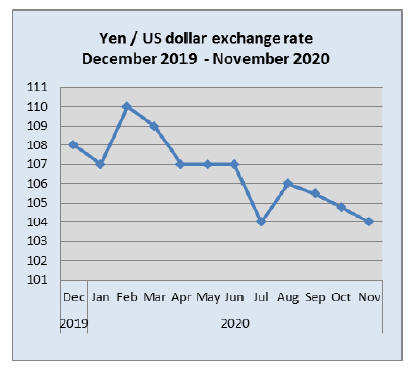
Young people embrace home relocation to
rural areas
The pandemic has created the new work-from-home style
and this in turn is offering people the opportunity to
relocate home to take advantage of lower housing/rent
costs and a healthier environment compared to that in the
cities.
The Ministry of Land, Infrastructure and Transport survey
early this year asked people what they thought of the
government¡¯s plan to offer grants to those wishing to
move to the countryside and work remotely. Twenty-three
percent of respondents (mostly young people) supported
the idea.
Data show that there has been a noticeable exodus of
people in their 20s and 30s from Japan's cities. In
September over 30.000 people moved out of the capital
Tokyo, up 12.5% year-on-year. September marked the
third consecutive month when those moving out
outnumbered those moving in.
The Japanese Prime Minister has made the revitalisation
of Japan¡¯s countryside one of the key goals for his
premiership and his government is offering Yen 1 million
grants to those who relocate to the rural areas but continue
to work remotely.
See:
https://www.weforum.org/agenda/2020/11/japan-tokyocities-city-countryside-pandemic-coronavirus-covid-19/
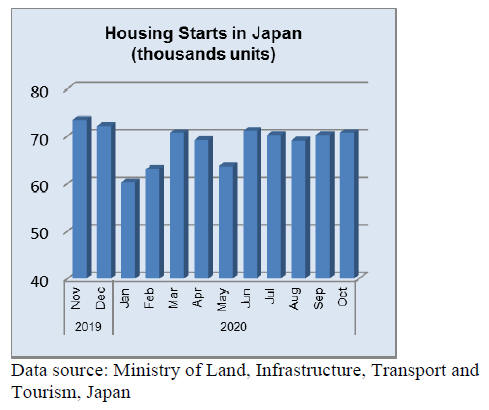
Import update
Wooden door imports
For each of the first three quarters of 2020 Japan¡¯s imports
of wooden doors (HS441820) were consistently below
those of 2019. Overall, first three quarter imports were
down over 20% compared to the same period in 2019.
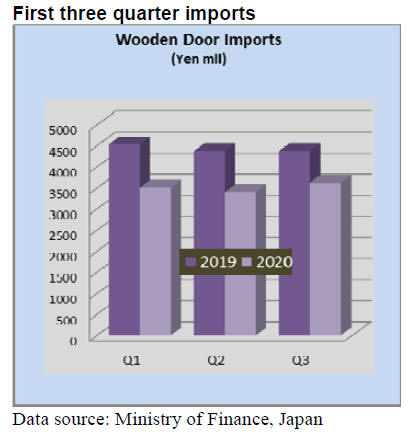
September imports
In September 2020 two shippers accounted for 85% of
Japan¡¯s imports of wooden doors, China 60% and the
Philippines 25%. Year on year September imports were
down 10% while compared to the value of imports in
August there was a 16% rise.
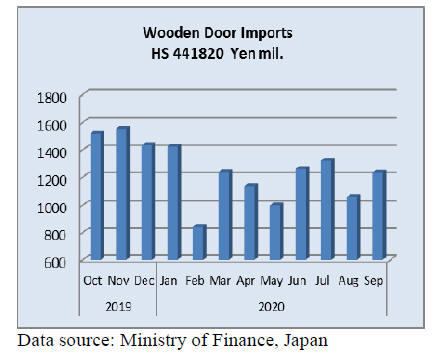
Wooden window imports
As was the case with wooden door imports, the value of
Japan¡¯s wooden window (HS441810) imports fell in each
of the three quarters of 2020 compared to 2019. The
overall combined decline for the three quarters was 22%.
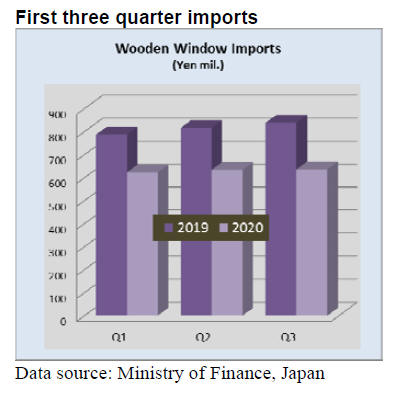
September imports
Japan¡¯s imports of wooden windows (HS441810) continue
to rise and fall such that there is no discernable trend.
The value of wooden window (HS441810) imports was
down 9% year on year but up 25% compared to August
levels. China, the US and the Philippines accounted for the
bulk of September imports with manufacturers in China
securing 43% of September imports followed by the US,
20% and the Philippines 18%.
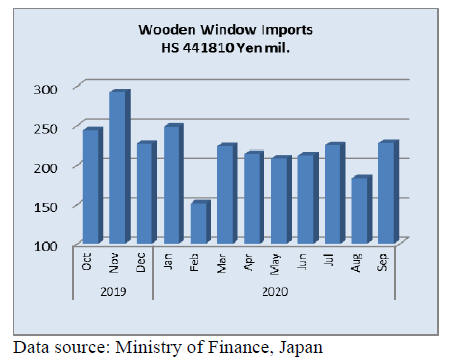
Assembled wooden flooring imports
Excluding the unexpected surge in Q2 2019 imports then
the value of 2020 assembled flooring imports into Japan
were much the same as in the previous year. The total
value of assembled flooring imports (HS441871-79) were
just 8% below that in the same period of 2019 but there
has been a steady downward trend in the value of imports.

September imports
HS441875 continued to dominate Japan¡¯s imports of
assembled flooring in September 2020 accounting for
around 70% of the various categories imported. HS441879
accounted for 18% of the value of September imports.
Year on year September imports were up 8% and there
was an 11% increase over the value of August imports.
Despite three months of steady increase in the third quarter
of this year the value of flooring imports is still well below
that of either the first or second quarter of the year.

Plywood imports
The volume of plywood imports into Japan has been
falling for almost a decade and the rate of decline has
accelerated in recent years. In the first three quarters of
2020 the volume of plywood imports was 10% below that
in the same period in 2019.
Each of the two main suppliers, Indonesia and Malaysia
have lost market share to domestically manufactured
plywood. Two other suppliers, China and more recently
Vietnam, on the other hand, have managed to maintain
market share.
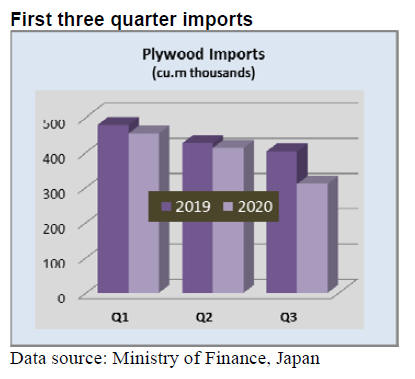
September imports
After an encouraging rise in the volume of plywood
(HS441210-39) imports in August, September marked the
return to the downtrend that has been evident all year.
September plywood imports were 30% down compared to
September 2019 and were 24% below the volume of
August imports. Indonesia saw an almost 40% decline in
the volume of September plywood exports to Japan and
Malaysia saw a 20% decline.
Of the various categories imported HS441231 accounted
for over 70% of imports with a further 5% each being of
HS441233 and HS441234.
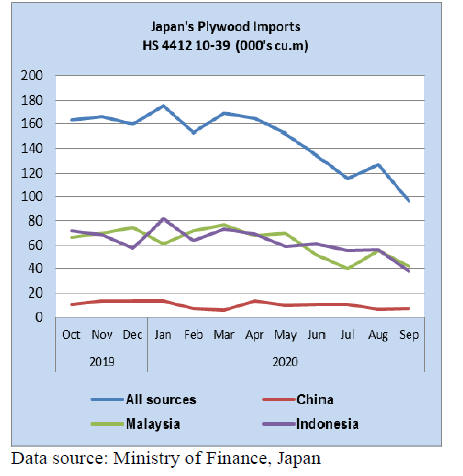 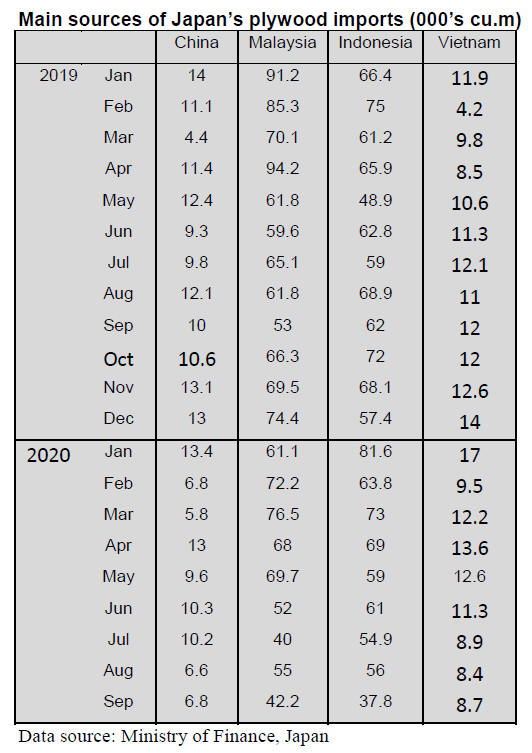
Trade news from the Japan Lumber Reports (JLR)
The Japan Lumber Reports (JLR), a subscription trade
journal published every two weeks in English, is
generously allowing the ITTO Tropical Timber Market
Report to reproduce news on the Japanese market
precisely as it appears in the JLR.
For the JLR report please see:
https://jfpj.jp/japan_lumber_reports/
JFHO proposes necessary measures to the
government
The Japan Federation of Housing Organizations (JFHO)
came up with economic measures for 2021 and submit to
the government. It figures economic impact in case that
housing starts decrease by 150,000-200,000 units. It could
be loss of 5.0 to 6.7 trillion yen and employment would
decrease by 410,000-550,000.
It uses forecast made by private think tanks. For fiscal year
2020, first half is 414,039 units, 11.3% less than the same
period of last year and total year¡¯s starts would be 783,380
units, about 100,000 units less than 2019. Forecast by 13
think tanks ranges from 814,000 to 730,000 units. JFHO
figures influence to the economy if the starts decrease
by150,000-200,000 units.
Average construction cost in 2019 are 16,210,000 yen per
unit so in case the starts decrease by 150,000-200,000
units, loss would be 2.4-3.2 trillion yen. Ripple effect by
this would be about4.7-6.3 trillion yen. Then loss of
durable consumer goods like home appliances and
furniture would be 150 to 210 billion yen. This much
economic impact influences consumers¡¯ mind and
employment.
To relieve sharp drop of housing JFHO proposes six
measures:
(1) Establishing point system for new life style. New life
style means prevention measures of COVID 19, change of
work style by increasing remote telework and longer time
to spend at home. Subsidy of maximum of two million yen
to assist changing life style including purchase of new
home or renovation to have an office at home for telework.
(2) Expansion of tax break for housing loan.
(3) Expansion of tax-exempt for donation tax in relation to
house purchase.
(4) Relief of space in special tax measure in case of
purchase of multi-family units.
(5) Securing budget for zero energy emission house.
(6) Simplify formalities for acquiring long life quality
house system.
Orders to housing companies
Average ordered value in October by eight major house
builders compared to the same month a year ago is 98%,
first decline since last July. April and May were bottom
then the orders have kept increasing through September.
The reason is that tax break of housing loan for order
made units ended at the end of September and visitors to
house exhibition sites decreased in September and orders
in October started declining.
Orders for other smaller builders have been steady over
100%. Now house builders are worried about raging
COVID 19 again, which makes difficult to contact
potential buyers.
Visitors to house exhibition sites steadily recovered after
the state of emergency was lifted in May for eight major
builders (Daiwa House, Sekisui House, Asahi Kasei
Homes, Sekisui Chemical, Panasonic Homes, Sumitomo
Forestry, Mitsui Home and Misawa Home).
The builders expected that momentum is so steady that it
could cover up shortfall during stay-home period of March
and April but after tax break deadline came, the orders
started sliding. Obviously rush-in orders pushed the orders
in September to 113% then October dropped down to
98%.
Housing loan tax break is that 1% of loan balance is
deducted from income tax. This applies to unit built for
sale through December this year.
This system is introduced when the consumption tax
increased to 10% and period of deduction extended to 13
years from 10 years so maximum of 4 million yen is
deducted in 13 years so buyers of high priced order made
units rushed to use this system. By this change, house
builders are afraid that orders would decrease toward
December.
Meantime, low cost house builders are enjoying steady
sales and visitors to the exhibition sites are unchanged
through October. Some builders report that there are more
inquiries of information.
Average of major eight for August is 108%, September is
113% then October is 98% and average for seven months
from April to October is 89%. Low cost mainly units built
for sale builders value is 131% in August, 139% in
September and 123% in October. Seven months average is
121%.
Climbing cedar log prices for China
Log export prices for China dropped when corona virus
started and economic activities died down in early spring
then the prices recovered after business activities returned
in China and lockdown in New Zealand.
Softwood log import in the first half of this year is 1,764
M cbms, 16.2% less than the same period of last year.
Beetle damaged logs from Europe increased considerably
while major supply sources of New Zealand, Russia and
U.S.A. decreased.
Export volume from Japan is almost unchanged from
2019. Since last April, monthly export volume has been
about 100,000 cbms and total volume through August is
717,193 cbms, 11.8% more than 2019. Obviously Chinese
made cedar fence board export to the U.S.A. market was
busy and more orders are increasing from China but
supply is not easy.
In public log auction market in early October, C class 4
meter 10-13 cm cedar log¡¯s successful bid prices are 7,500
yen. Log exporters¡¯ purchase prices are 8,000-8,500 yen
per cbm delivered shipping port in early November, which
is about 1,000 yen higher than the bottom prices.
New Zealand radiate pine log export prices for China
climbed to US$125, about US$15 higher than the bottom
prices. Japanese cedar export prices are more than $120
and large diameter log prices are higher than this level.
Log exporters¡¯ purchase prices are rising in tight supply so
the export prices are likely to go up more. Chinese demand
seems to stay active at least until Chinese New Year in
February. As weather has been favorable in Kyushu, the
exporters wonder why log supply is not increasing. They
suspect the log suppliers try to control the volume in fear
of price drop by over-supply.
South Sea (tropical) logs
Supply and demand of South Sea logs are well balanced.
In log producing regions in South East Asian countries,
rainy season arrived about two months sooner this year
and log production is decreasing but log inventory in
Japan was 2.6 months at the end of September. Demand of
plywood and lumber is stagnating. One South Sea log
plywood manufacturer, which will go out of business in
March 2021, procured larger volume so October arrivals
are high.
|